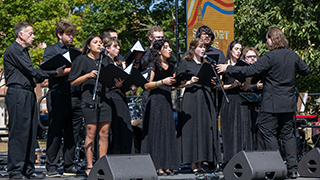Anthropology Professor Rhonda Quinn Contributes to Major Discovery that Could Change the Evolutionary Timeline
Wednesday, June 24th, 2015

“The origins of tools have long been associated with our genus, but these new finds occur before significant brain expansion,” said Quinn. “It begs the question – was brain expansion necessary to make stone tools? And if not genus Homo, then who was the toolmaker?”
Quinn’s role in the research was to recreate the environment in which the stone tools were found, using a process called stable isotopic analysis in her Seton Hall lab to determine the mineral composition of ancient soils.
“We learned that the tools were made and potentially used in a wooded environment, not in grasslands. These findings suggest that there may have been other things driving human evolution besides large-scale environmental change. The answer may lie in small changes that so far have gone unnoticed,” Quinn said.
Quinn says the neat package that has been the standard evolutionary story of humankind – that global climate change turned forests into savanna grasslands, changing the diet of our human ancestors, and causing brain expansion and the development of stone tools to scavenge – may be coming apart because of her team’s game-changing discovery.
“Climate change may not be the only ‘big bang’ of human evolution. We will have to keep looking to see if something else could have potentially caused behavioral changes,” Quinn said.
The West Turkana Archeological Project first made the cover of Nature in 2011, with the discovery of the oldest hand axes. The group’s work continues in Kenya as the scientists seek more clues in understanding human evolution.
Quinn is the recipient of a $454,000, five-year National Science Foundation Career grant, which will be used to teach the stable isotopic analysis process to undergraduate students at Seton Hall. The first group begins a three-week intensive training course on Mon., Aug. 3. Quinn plans to have the students work on samples she has gathered from archeological digs around the world, including Lake Turkana, but also will encourage the students to apply the process to their own areas of interest and study.
“My vision is to create a learning community of young researchers, doing nuts and bolts research, while learning an important tool,” Quinn said. “I am hoping the students will use the research experience to build confidence in their abilities to ask their own questions.”






